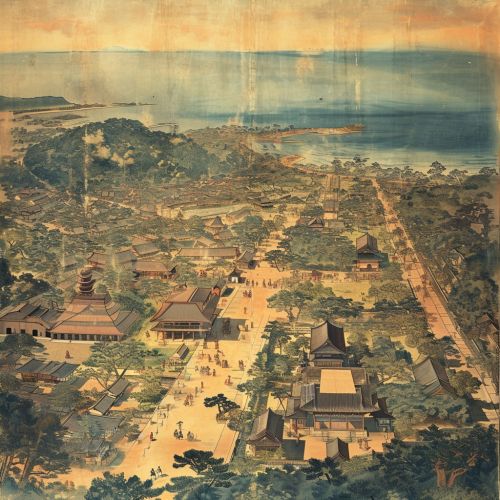Kamakura period
Overview
The Kamakura period (1185–1333) was a significant era in Japanese history that marked the governance of the Kamakura shogunate, Japan's first military government. The period is known for the emergence of the samurai, the warrior caste, and for the establishment of feudalism in Japan.

Historical Context
The Kamakura period was preceded by the Heian period, a time of courtly refinement and aristocratic culture. The transition to the Kamakura period was marked by a shift in power from the imperial court to the military class. The Kamakura period is named after the city of Kamakura, the administrative center of the first shogunate.
Kamakura Shogunate
The Kamakura shogunate was established by Minamoto no Yoritomo after his victory in the Genpei War. The shogunate system was a form of military government that became a recurring feature in Japanese history. The Kamakura shogunate marked the rise of the samurai class and the establishment of a feudal system in Japan.
Society and Culture
The Kamakura period was marked by significant changes in Japanese society and culture. The rise of the samurai class and the establishment of a feudal system had profound effects on social structure. The period also saw the spread of Buddhism among the common people, the development of distinct forms of Japanese literature, and the emergence of new forms of art and architecture.
Religion
The Kamakura period was a time of religious transformation in Japan. Amidst the societal upheaval, new forms of Buddhism, such as Pure Land Buddhism and Zen Buddhism, gained popularity. These forms of Buddhism offered spiritual solace to the common people and the samurai class alike.
Literature and Art
The Kamakura period saw the development of a distinct form of Japanese literature, characterized by works written in the vernacular language. The period also witnessed the emergence of new forms of art and architecture, including the construction of large bronze statues of Buddha and the development of the Kamakura-style of sculpture.
Decline and End
The Kamakura period ended with the overthrow of the Kamakura shogunate in the Kemmu Restoration. The fall of the Kamakura shogunate marked the end of the feudal system in Japan and the beginning of the Muromachi period.
